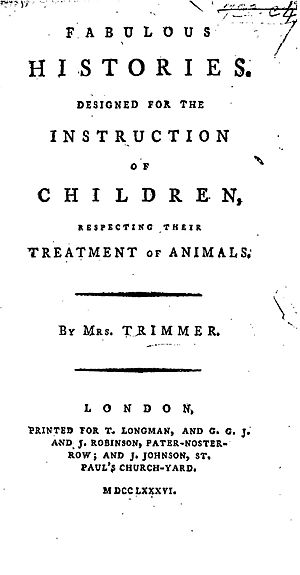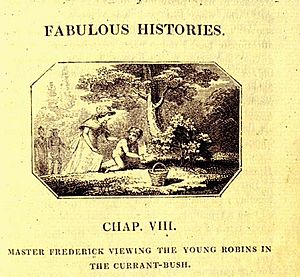Fabulous Histories facts for kids
Fabulous Histories (also known as The Story of the Robins) is a famous book by Sarah Trimmer. It was first published in 1786 and was popular for a long time, staying in print until the early 1900s.
Contents
What is Fabulous Histories About?
Fabulous Histories tells the story of two families: one family of robins and one human family. They learn to live together in a friendly way. The children and baby robins learn to be kind and avoid bad behavior.
Sarah Trimmer believed that if children practiced kindness to animals, they would grow up to be kind to everyone. A scholar named Samuel Pickering Jr. said that Trimmer's book was a great example of how people thought about animals in the 1700s.
Main Ideas in the Book
The book shares several important ideas that were common in Sarah Trimmer's other works.
Social Order and Kindness
One main idea is about keeping social order. This means that parents have authority over children, and humans have authority over animals. For example, the book suggests that poor people should be helped before hungry animals. However, the book does not clearly state that men are above women in the same way.
Another scholar, Moira Ferguson, explains that the book also shows the author's worries about big changes happening in society, like the start of the Industrial Revolution. The book encourages kindness to animals but also supports Britain's actions in other countries. It quietly suggests keeping things as they are, following rules, and accepting one's place in society.
Fiction Versus Reality
Another important idea in the book is about being logical and realistic. In her introduction, Trimmer tells her young readers that her story is not real. She explains that animals cannot truly speak.
Like many people in the 1700s, Trimmer worried that made-up stories (fiction) could be harmful to young readers. With more novels being read privately, she feared that young people, especially girls, might read exciting stories without their parents knowing. Even worse, they might understand these books however they wanted.
Because of this, Trimmer always called her book Fabulous Histories to show it was based on facts, not just imagination. She also did not allow pictures in the book during her lifetime. She thought pictures of talking birds would make the story seem too much like fiction, which she wanted to avoid. Some people believe that many characters in the book were based on Trimmer's own friends and family.
What Critics Thought
Murray Knowles, a writer about children's literature, said that Trimmer wanted the book to teach lessons. This was a common goal for children's books in the 1700s.
More than a hundred years later, Edward Salmon wrote that the book was "nothing unusually meritorious," meaning it wasn't super special. However, he did say it "should be praised for its humane sentiments," meaning it was good because it taught kindness.
See also
 In Spanish: Fabulous Histories para niños
In Spanish: Fabulous Histories para niños



